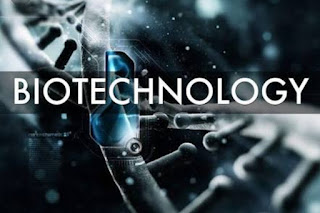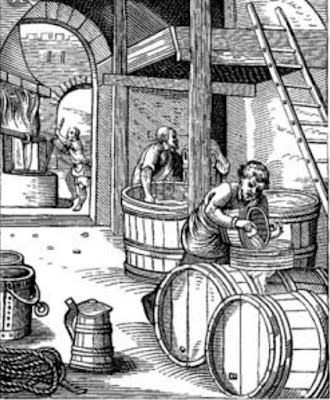Biotechnology:
It is primarily biological technology, especially when the technology is used in agriculture, food science, and pharmaceuticals. The term biotechnology was first coined in 1919 by Hungarian agricultural engineer karloy ereky.
What is biotechnology?
According to the United Nations Convention on Biological Diversity, biotechnology can be defined as"Any technological application that uses biological systems, dead organisms, or derivatives thereof, to make or modify products or processes for specific use."
History:
Although biotechnology has been used in agriculture for a long time, its latest application in plant cultivation can be seen.
Agriculture has been considered the most influential means of food production since the Neolithic Revolution of the Neolithic Age. Modern day farmers are meeting the food needs of the growing population by selecting and using the best seeds to achieve maximum yields.
When the amount of grain and land increased and got out of control, some organisms and their derivatives were found, which increased soil fertility, accumulated nitrogen, and suppressed harmful pests or pests.
In the history of agriculture, it has been seen that the farmer has brought out the earliest forms of biotechnology by breeding a plant with different plants in different environments and making some changes in the genes of the plants.
An example of beer fermentation and primitive biotechnology. These methods were common in Mesopotamia, Egypt, China, and India, and the biological principles of the methods still remain the same.
Although this process was not clearly understood before Louis Pasteur's work on fermentation in 1856, it was the earliest form of biotechnology to convert one type of food into another.
 |
| Luis pasture |
The fermentation process breaks down the carbohydrates in different types of food to produce alcohol.
For thousands of years humans have used artificial insemination methods to increase grain and animal production. In this method the offspring produced by the union of the expected advanced traits possess the same characteristics. For example, this method was used to produce the largest and sweetest corn.
At the beginning of the twentieth century, scientists began to gain a great deal of information about microorganisms and to discover new ways of processing products. In 1918, Chaim Weizmann applied the first pure microbial culture to commercial activities. He processed corn starch with the help of Clostridium acetobutylicum bacteria to produce acetone, which the United Kingdom needed to make explosives during World War I.
Biotechnology has also been used to improve antibiotics. Alexander Fleming discovered the Penicillium mold in 1926. His work led Howard Florey, Ernst Boris Chain and Norman Heatley towards the invention of penicillin. Penicillin has been used to treat bacterial infections in humans since the 1940s.
Application:
The application of biotechnology can be seen in 4 important cases. These are happening
- Health
- Agriculture
- Use of grains and other products in industry (eg biodegradable plastics, vegetable oils, biofuels)
- Environment
Biotechnology is the application of microorganisms in the processing of organic matter. The use of bacteria in ore extraction is also an example of biotechnology. In addition, biotechnology is used to make things reusable, to treat waste, to clean contaminated areas by factories, and to make biological weapons.
Some words or terms have been coined to identify different branches of biotechnology. Such as: -
1. Golden biotechnology or gold biotechnology:
This branch is based on Bioinformatics, an interdisciplinary field of biotechnology where biological problems can be quickly sorted and data analyzed using computer technology. It plays an important role in various other fields. Such as functional genomics, structural genomics and proteomics which help to form the core components of biotechnology and pharmaceuticals.
2.Blue biotechnology :
Mainly the field of production of various products in the industry by utilizing marine resources. For example, photosynthetic micro-algae are used to refine biofuels.
3. Green biotechnology :
The branch of biotechnology where biotechnology is applied in agriculture. For example, many plants can be produced simultaneously through micropropagation. Production of various disease resistant and high yielding plants made of transgenic plants (plants produced by inserting genes from outside) to grow in certain environments.
4.Red biotechnology :
Biotechnology used in medicine and the pharmaceutical industry. The activities of this branch are making vaccines and antibiotics, various therapies, making artificial organs, making artificial hormones, making stem cells etc.
5.White biotechnology :
It is also called industrial biotechnology because this technology is used in the industrial field. For example, proper use of various enzymes controls the speed of chemical reactions and produces various important chemicals and destroys harmful chemicals.
6.Yellow biotechnology :
Biotechnology used in food production. For example, production of wine, cheese, beer etc. by fermentation method. Biotechnology used in the field of various insects is also a topic of this branch.
7.Gray biotechnology:
Biotechnology applied to the environment. Its main goal is to maintain the natural balance and eliminate environmental pollution.
8.Brown biotechnology:
Biotechnology used to control the environment in arid or desert areas. In this case, seeds are produced using biotechnology which is able to deal with difficult natural problems.
9.Violet or purple biotechnology :
This field deals with the legal, ethical and philosophical aspects of biotechnology.
10.Dark biotechnology :
The use of biotechnology in terrorism, including the manufacture of biological weapons, is part of this branch.






0 Comments
Please do not enter any spam link on the comment box